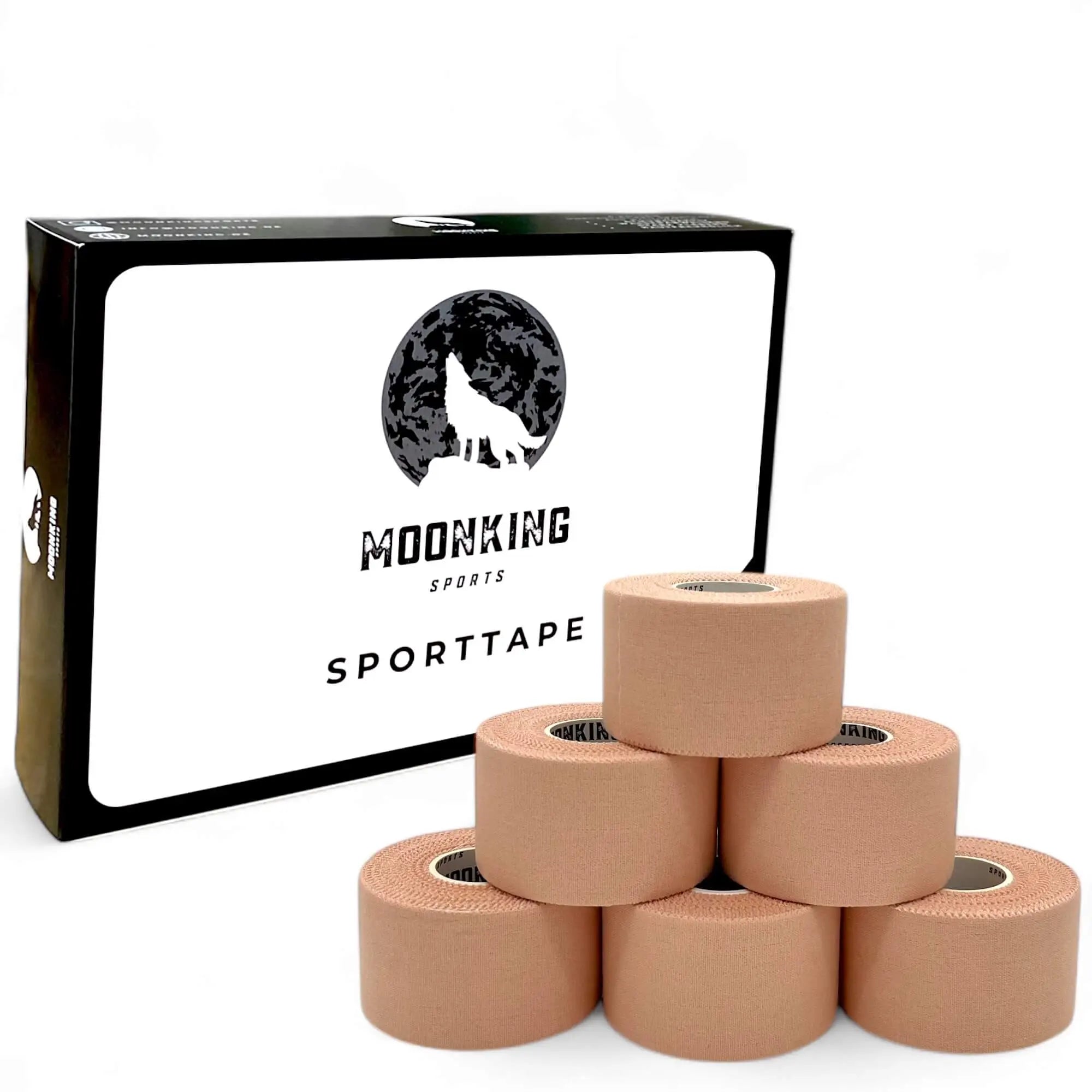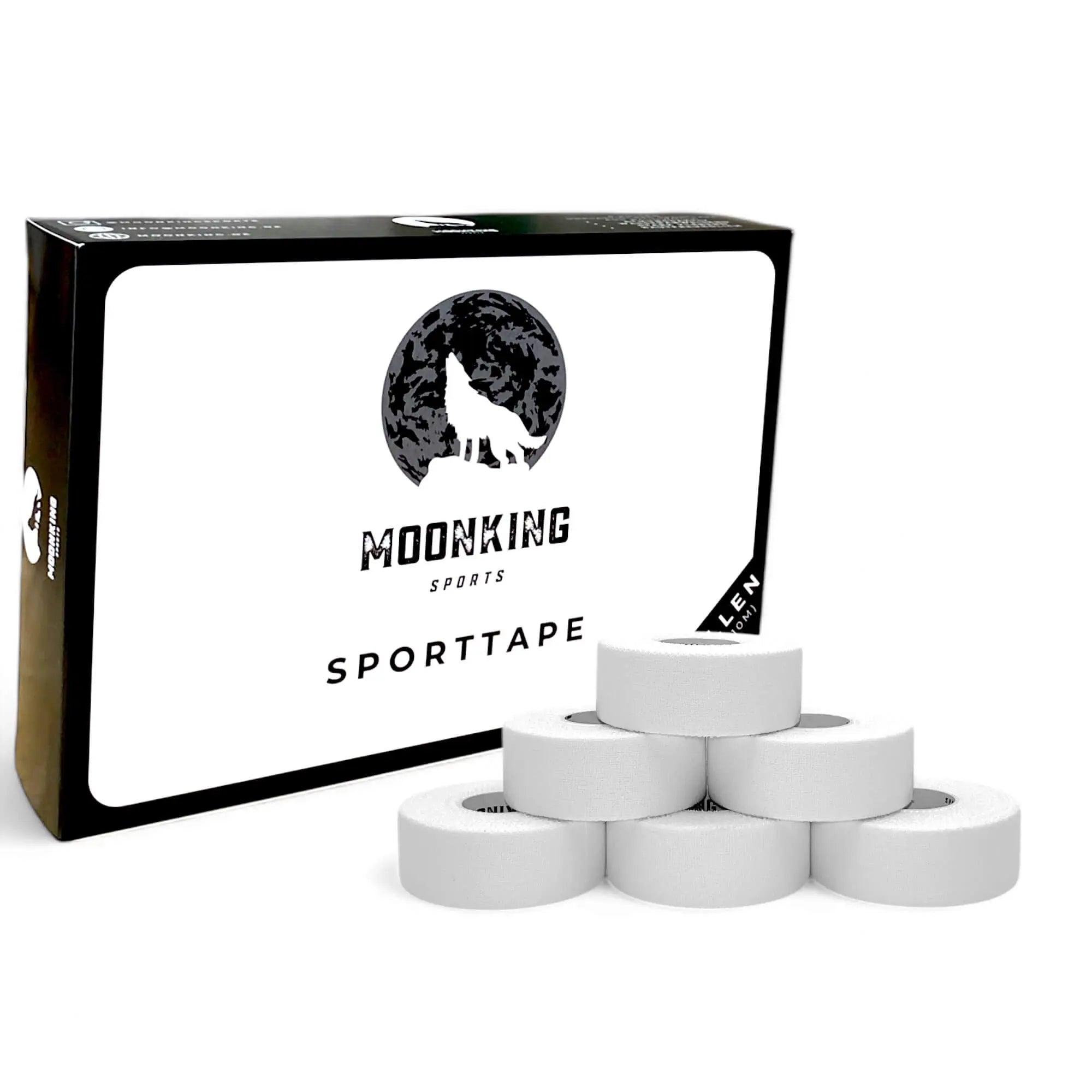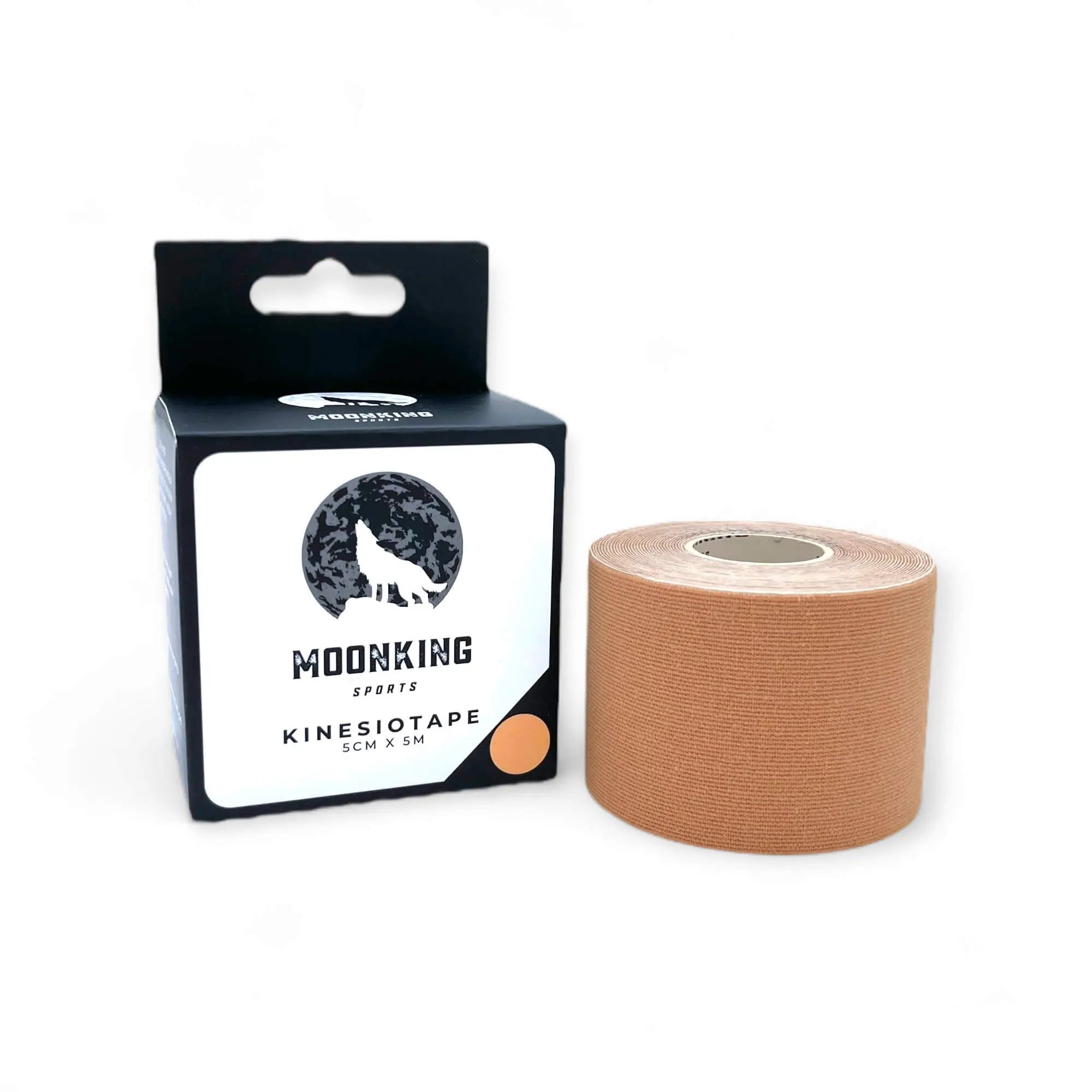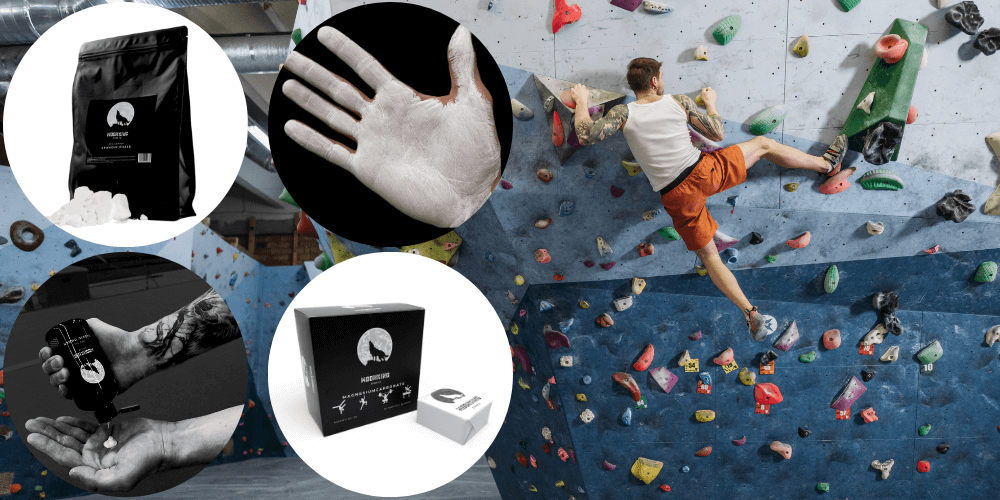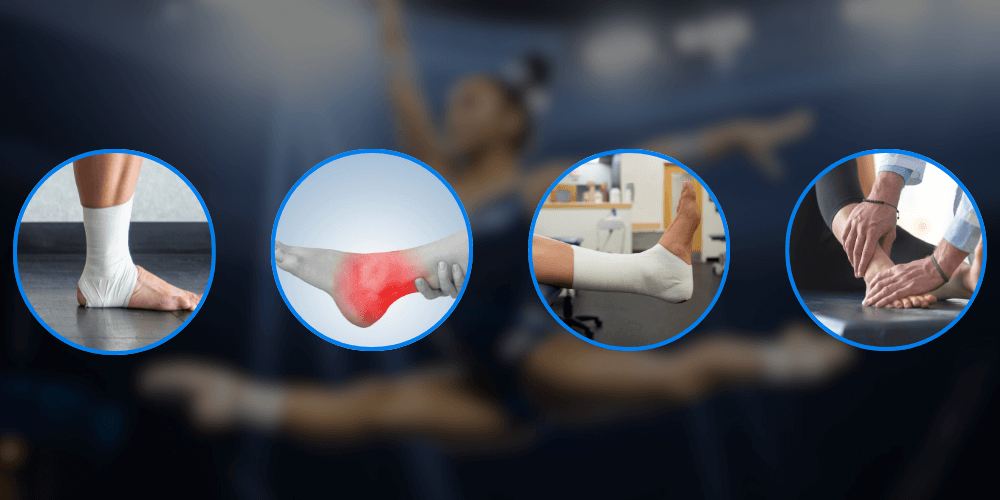The ankle is one of the most important joints in your body - it bears the entire weight and is constantly moving. When doing sports, whether running, climbing, basketball or gymnastics, the risk of twisting your ankle is particularly high. This makes it all the more important to take preventative measures and protect your ankles as best as possible. In this detailed blog post, we show you well-founded tips and tricks on how you can effectively prevent twisting your ankle. We draw on scientifically based findings and present you with practical exercises, training routines and aids. You will also learn how our high-quality tape products can help you stabilize your ankles - so that you are always safe and confident when you are out and about.
1. Introduction: Why protecting your ankles is so important
Your ankles are exposed to enormous stress every day - not just in everyday life, but especially when playing sports. Every movement, every jump and every quick change of direction places high demands on the stability and flexibility of your joints. Spraining your ankle can not only lead to painful injuries such as torn ligaments, but can also severely hinder your training progress. That's why it's crucial to take preventative measures and strengthen your ankles.
If you learn how to prevent sprains, you will not only protect your joints, but also increase your general performance. Through targeted measures - from warm-up exercises to strengthening and stretching exercises to the use of stabilizing tape products - you can optimally support your ankles. Below you will find out everything you need to know to minimize your risk of injury and achieve your sporting goals.
2. The anatomy and function of the ankle
To understand the importance of the ankle joint and the need to protect it, it is helpful to take a quick look at its structure.
2.1 Anatomy of the ankle
The ankle is made up of several bones, ligaments, tendons and muscles that work together to provide movement and stability:
- Bones: The most important bones include the shinbone (tibia), fibula, and talus. These bones form the main joint responsible for leg strength and mobility.
- Ligaments: Several strong ligaments, such as the lateral ligament (ligamentum talofibulare anterius) and the medial ligament, secure the connection between the bones. These ligaments prevent the joint from overextending or twisting.
- Muscles and tendons: The surrounding muscles, especially the calf muscles, contribute to stability, while tendons transfer muscle power directly to the bones.
2.2 Function of the ankle joint
The ankle allows you to perform the following movements:
- Dorsiflexion and plantar flexion: Raising and lowering the foot, for example when walking or running.
- Inversion and eversion: The inward and outward movement of the foot, which plays an important role in rapid changes of direction.
- Stability and shock absorption: The joint acts as a buffer that absorbs the shocks that occur when running and jumping.
With this knowledge it becomes clear how important it is to protect the ankle from excessive strain and twisting.
3. Causes and risk factors for sprains
Before you can take effective measures, it is important to understand the causes of the ankle sprain. Various factors can contribute to the ankle becoming unstable and causing you to sprain:
3.1 Lack of muscle and stability
- Weak leg muscles: If the calf and shin muscles are not sufficiently trained, they often lack the necessary stability to protect the ankle during sudden movements.
- Imbalance: A muscular imbalance, for example between the front and back thigh muscles, can also lead to instability.
3.2 Insufficient proprioception
- Coordination problems: Proprioception refers to body awareness, i.e. the perception of the position and movement of your limbs. Poor body awareness can lead to you not being able to control your movements precisely, which increases the risk of twisting your ankle.
3.3 External factors
- Uneven surfaces: Irregular ground, uneven climbing rocks or unstable gymnastic equipment can increase the risk.
- Poor equipment: Inappropriate shoes or a lack of grip on climbing holds also contribute to twisting your ankle.
3.4 Previous injuries
- Ligament injuries: If you have already suffered a ligament tear or sprain, your ankle is more susceptible to further injuries. This unstable situation can be improved through targeted measures.
4. Effective tips and tricks to prevent sprains
Below we present a variety of tips and tricks to help you protect your ankles. These strategies are based on sound scientific findings and practical experience from athletes.
4.1 Warm-up and stretching exercises
A thorough warm-up and stretching is the basis for every training session. It prepares your muscles and joints for the strain and reduces the risk of injury.
4.1.1 Dynamic warm-up
- Leg swings: Swing your leg back and forth and sideways to loosen your muscles.
- Jumping exercises: Light jumping exercises such as hopping or skipping rope activate your ankles and increase blood circulation.
- Running ABC: Exercises such as knee lifts, heel raises and lateral running improve coordination and mobility.
4.1.2 Stretching exercises for the legs
- Calf stretch: Stand in front of a wall, lean against the wall and stretch one leg backwards to stretch the calf muscles.
- Shin stretch: Sit on the floor and stretch your legs. Try to pull your toes towards your body to stretch the shin area.
- Ankle circles: Lift one foot and slowly circle it clockwise and counterclockwise. This exercise improves mobility and promotes blood circulation.
4.2 Strengthening exercises for more stability
Strong muscles stabilize your joints and prevent them from being stressed beyond their natural range of motion.
4.2.1 Strengthening the calf muscles
- Calf raises: Stand on your tiptoes and slowly lower your heels. Vary this exercise by doing it on one leg.
- Climbing stairs: Use stairs or a step box to specifically train your calf muscles.
4.2.2 Build leg muscles
- Squats: Do squats to strengthen your thighs and glutes. Make sure you do them correctly so you don't overstress your knees and ankles.
- Lunges: This exercise improves both strength and stability in the legs and promotes balance.
4.2.3 Proprioception and Balance
- One-legged stand: Stand on one leg and hold this position for 30 seconds to a minute. To intensify the exercise, you can close your eyes or stand on an unstable surface such as a balance pad.
- Balance boards: Use a wobble board or Bosu ball to train your balance. These devices force you to constantly adjust your ankles, which improves proprioception.
4.3 Special taping techniques to protect the ankles
Tape products are an effective tool to provide additional stabilization to your ankles and minimize the risk of twisting. On our website you will find a wide selection of high-quality tapes that have been specially developed for this purpose.
4.3.1 Sports tape for stabilization
Sports tape is an inelastic tape that is mainly used to stabilize joints. It limits excessive movements and ensures that the ankle remains in a safe position.
Application examples:
- Ankle bandage: Apply the sports tape so that it stabilizes the ankle from the outside. Make sure that the tape is tight, but not too tight, so as not to impair blood circulation.
- Preventive use: Even if you do not currently have an acute injury, regularly wearing sports tape can provide additional support during risky activities.
4.3.2 Kinesio tape for dynamic support
Kinesio tape is characterized by its high elasticity and supports your natural movement. It can also help with slight instabilities without restricting freedom of movement.
Application examples:
- Support in case of overload: During longer training sessions or competitions, you can apply kinesiotape to relieve the ankle joint and at the same time provide a certain degree of stability.
- Combination with sports tape: It often makes sense to use kinesiotape as a base and apply sports tape on top - this way you benefit from both properties: dynamic support and firm stabilization.
4.3.3 Underwrap tape as skin protection
Underwrap tape is a thin, elastic adhesive tape that serves as a base for sports or kinesiology tape. It protects your skin from irritation and at the same time improves the adhesion of the tape above.
Application examples:
- Combination application: First apply underwrap tape to the ankle before applying sports or kinesiology tape. This will prevent skin irritation and increase the duration of the tape.
4.4 Correct shoe selection and insoles
In addition to exercises and tape products, the right footwear also plays a crucial role in protecting the ankles.
4.4.1 Stability and fit
- Shoes with good stability: When buying sports shoes, make sure that they offer you a firm stance and sufficient support in the ankle area.
- Correct fit: Shoes that are too tight or too wide can lead to misalignment. If necessary, seek advice from a specialist shop.
4.4.2 Insoles and orthoses
- Special insoles: Orthopedic insoles can help to correct the position of the foot and thus relieve pressure on the ankle.
- Individual adjustment: There are also individually made insoles that are tailored exactly to your needs.
4.5 Training planning and recovery
In addition to targeted exercises, a well-structured training plan is crucial to prevent sprains in the long term.
4.5.1 Regeneration and recovery
- Sufficient recovery time: Plan enough rest periods between intensive training sessions so that your muscles and joints can recover.
- Ice treatments: For mild pain or after intense exercise, icing the ankle can reduce swelling and promote healing.
4.5.2 Continuous stability training
- Regular balance training: Integrate balance and coordination exercises into your training regularly. This not only improves the stability of your ankles, but also helps you to sharpen your body awareness.
- Periodization: Work with training cycles in which you alternate phases of intensive training with regenerative units. This minimizes the risk of overuse injuries.
5. Practical tips from everyday life
In addition to training and technique tips, there are numerous everyday measures that can help you protect your ankles.
5.1 Conscious movement and mindfulness
- Increase slowly: Increase the intensity and duration of your training gradually so as not to overload your body.
- Mindfulness in everyday life: Pay attention to your posture and the way you move in everyday life. Even small changes can make a big difference.
5.2 Regular inspection and maintenance
- Self-check: Check regularly whether your ankles are stable and whether there are signs of overload.
- Professional advice: Do not be afraid to consult a physiotherapist or sports doctor if you notice pain or insecurities.
5.3 Combination of measures
- Multifactorial approaches: The combination of targeted training, the right equipment (shoes, insoles) and supporting tape products is often the key to success.
- Individual adjustment: Every athlete is different. Experiment with different methods and find out what works best for you.
6. Our tape products at MoonKing – your additional protection
To protect your ankles as best as possible, we offer a wide range of high-quality tape products that have been specially developed for stabilization and support. Here is an overview of our most important products:
6.1 Sports tape
Our sports tape is ideal if you need maximum stability. It is an inelastic tape that effectively prevents excessive movements of the ankle joint due to its firm application.
Advantages:
- High stability and protection
- Easy to use
- Particularly suitable for acute stress and injury prevention
Application:
Apply the sports tape before intensive training sessions or competitions to provide additional protection for the ankle. Our instructions on the website show you step by step how to apply the tape optimally.
6.2 Kinesio tape
For anyone who wants dynamic support, our Kinesio tape is the perfect choice. It is highly elastic and supports your natural movement while stabilizing the ankle.
Advantages:
- Maintains full freedom of movement
- Promotes blood circulation and supports the body's self-healing powers
- Ideal for use during longer training sessions and for regeneration
Application:
You can use kinesiology tape for minor instabilities or for support during training. It is also excellent for promoting healing after injuries.
6.3 Underwrap Tape
Underwrap tape serves as skin protection and ensures that the tape on top adheres optimally. It minimizes skin irritation and extends the life of your tape applications.
Advantages:
- Protects your skin from direct tape contact
- Improves the adhesion of sports and kinesiology tape
- Cost-effective and easy to use
Application:
Apply the underwrap tape as a first layer before applying sports tape or kinesiology tape – this will give you optimal results without skin irritation.
7. Experience reports and scientific background
7.1 Athletes' testimonials
Many athletes report significant improvements since they started protecting their ankles. Here are some testimonials from practice:
"Since I've been using MoonKing sports tape regularly, I feel much safer. I no longer have the feeling of twisting my ankle when playing basketball or running - my ankle stays stable and I can fully concentrate on my game."
– Markus, basketball player
"As a passionate gymnast, I was always worried about twisting my ankle during complex elements. The kinesiotape from MoonKing has really improved my technique - I feel dynamically supported and know that my ankle is optimally protected."
– Lisa, competitive gymnast
7.2 Scientific findings
Studies show that targeted stabilization measures can significantly reduce the risk of twisting an ankle. In particular, the combination of targeted strength training and supporting tape products leads to better proprioception and greater stability in the ankle. Research also shows that the use of kinesiotape promotes blood circulation and thus supports the healing process in the case of minor injuries. These scientific findings confirm the benefits of our products and underline how important it is to take preventive action.
8. Training plans and routines to strengthen the ankle
A structured training plan can help you stabilize your ankles in the long term and minimize the risk of twisting them. Here is an example of a training plan that you can integrate into your weekly schedule:
8.1 Week 1-2: Laying the foundations
-
Warm-up:
Start each workout with 10-15 minutes of dynamic warm-up (running ABC, leg swings, jumping exercises). -
Balance and coordination training:
3 sets of 30 seconds each standing on one leg, alternating with and without eyes closed. -
Strength training:
3 sets of calf raises (15 reps per leg) and 3 sets of lunges (12 reps per leg). -
Tape application:
Test your technique with our sports tape – practice applying it correctly to your ankle.
8.2 Week 3-4: Intensification and stabilization
-
Warm-up:
Increase the intensity of your warm-up by an additional 5 minutes, including jumping rope. -
Balance training:
Use a balance board or Bosu ball for 3 sets of 45 seconds of one-legged stance. -
Strength training:
Incorporate single-legged squats (3 sets of 10 reps per leg) and increase the number of reps on calf raises (3 sets of 20 reps). -
Tape application:
Switch between sports tape and kinesiology tape – learn when which method offers you more security.
8.3 Week 5-6: Measure and adjust progress
-
Warming up and stretching:
Continue to use the dynamic warm-up, supplemented by special stretching exercises for the calves and shins. -
Strength and balance training:
Increase the intensity of the exercises, e.g. by adding additional weights to the lunges or more intense exercises on the balance board. -
Tape application:
Include the use of underwrap tape in your training plan to avoid skin irritation and extend the holding time.
Through regular training and the consistent application of these measures, you will not only improve your ankle stability, but also gain more overall security and self-confidence in your sporting activities.
9. Long-term strategies for protecting your ankles
In addition to daily measures, there are also long-term strategies to permanently minimize the risk of twisting an ankle:
9.1 Regular review and adjustment
-
Self-observation:
Pay attention to how your ankles behave over time. If you notice signs of overload or instability, adjust your training. -
Expert advice:
A regular check-up with a physiotherapist or sports doctor can help you identify and resolve potential problems early on.
9.2 Integration of regeneration techniques
-
Massage and fascia training:
Regular self-massage or the use of fascia rolls can relieve tension and promote blood circulation. -
Ice and heat applications:
Use ice treatments after intense workouts to reduce swelling and heat to relax muscles.
9.3 Sustainable training habits
-
Periodization:
Plan your training cycles so that intensive phases alternate with recovery phases. This prevents overload and enables continuous improvement. -
Variety in training:
Vary your exercises regularly to avoid one-sided strain. Combine strength training, balance exercises and endurance training to strengthen your entire musculoskeletal system.
10. Summary and Conclusion
Sweaty hands, unstable ankles and twisting are challenges that many athletes are familiar with - but with the right measures you can effectively counteract these risks. In this article we have presented you with comprehensive tips and tricks that are based on well-founded facts and practical experience.
We have shown you how important a thorough warm-up, targeted strengthening and stretching exercises and continuous balance training are. Tape products also play a key role in protecting your ankles. Whether it is sports tape, kinesiology tape or underwrap tape - each of these products offers specific advantages that help you to minimize the risk of twisting an ankle while optimizing your athletic performance.
Our products are the result of years of experience and are based on the latest scientific findings. We know how important it is for you to feel safe with every movement - whether running, climbing, gymnastics or other sporting activities. By using our tape products in a targeted manner, you can not only stabilize your ankles, but also strengthen your confidence in your sporting abilities.
Conclusion:
You are worth taking your training to the next level and preventing injuries. With the tips and tricks presented in this article, you are well equipped to protect your ankles in the long term. Use our high-quality tape products to increase your stability and integrate regular strength, balance and coordination training into your training plan. This will not only allow you to train more safely, but also increase your sporting success.
Remember: The best prevention is always a combination of training, targeted precautions and high-quality aids. If you are looking for solutions that will really help you, then you have come to the right place. Our products are designed to offer you the best possible support and protection - so that you can concentrate fully on your sporting goals.
11. Final Thoughts and Outlook
Protecting your ankles is a long-term process that requires both continuous training and the right equipment. It's not just about avoiding acute injuries, but also about sustainably improving your general stability and performance. By consistently applying the measures presented here, you will notice that you not only become physically stronger, but also develop more mental self-confidence.
Take your time to integrate the individual tips into your everyday life and experiment to find out which combination of exercises, tape products and regeneration techniques works best for you. Every athlete is different - and it is precisely this individuality that makes the difference between average and outstanding performance.
Our mission at MoonKing is to support you with the best products and in-depth knowledge. We are constantly working to develop innovative solutions that help you train safely and effectively. Whether you are an ambitious professional or a dedicated amateur athlete - with the right preparation and the right equipment you can achieve any goal.
12. Your next step
Now that you have read this detailed guide, you are well informed about how to protect your ankles from twisting. Now it is up to you to put the tips into practice and adapt your training routine accordingly. Also take a look at our product range - here you will find a large selection of tape products that have been specially developed to offer you additional support and safety.
Invest in your health and performance – your ankles will thank you. With the right measures and high-quality products, you are well equipped to master your sporting challenges and prevent injuries.
Important NOTE:
This blog post is for informational purposes only and is not a substitute for a visit to your doctor or professional medical advice. If you have any health problems or specific questions, you should always consult a doctor or physiotherapist.



